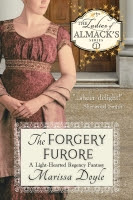1776 might not have been the best of years for George III, but it was not without its bright spots; one of those occurred on April 25, when his eleventh child and fourth daughter was born. Mary (yes, that’s all—had her parents grown tired of bestowing multiple names on their numerous offspring, or had they just run out??) came into the world at Buckingham House in London, and was destined to outlive her numerous siblings…but let’s not get ahead of ourselves!
Just as her elder three sisters formed a sort of subgroup within the family, Mary would become the eldest in a second sisterly subgroup, along with future siblings Sophia and Amelia.) The practical upshot of this was that my now, with eleven children, the king and queen simply didn’t have as much time and attention for the younger ones, and Mary and her sisters would not receive the same careful academic education that the Princess Royal, Augusta, and Elizabeth had.
As it happened, though, Mary did fine without it, for her intelligence was less academic than it was interpersonal. She was a charming baby who grew into a charming toddler, already described at sixteen months by one of the royal household as “a lovely elegant made child” and by another, a few years later: “There never was a child so consummate in the art of pleasing, nor that could display herself to such advantage.” While still small, she became the lifelong favorite sister of her eldest brother, the Prince of Wales, and indeed of many of her siblings.
After that rocky start in 1776, the world in which Mary grew up remained a rocky place, especially after the French threw in their support for the American independence effort and, a few years later, had their own revolution. It was a world that the king hesitated to allow his daughters out into, and so Mary’s debut at age 15 meant she was joining her elder sisters in spinsterhood. Unlike them, though, Mary seemed reasonably content in her single state; her name would never be connected (at least not seriously) with a secret lover’s, though she did strive to be out in society as much as possible; she loved attending the theater and such balls and parties as she was allowed to. She had grown into the beauty of the family, darker of hair and finer of feature, and had an excellent fashion sense (sharing her love of clothes with the Queen)…but emotionally, seems to have cared only for her parents and siblings and her cousins the Gloucesters, children of one of her father’s estranged brothers.
As her younger sister Amelia’s health declined in the first decade of the new century, Mary became her devoted companion and nurse (and conspired in Amelia’s doomed love for Charles Fitzroy. Amelia’s death in 1810 and the king’s subsequent final descent into madness marked the beginning of changes for the family; by 1813, the remaining sisters, now in their thirties and forties, were settling into new homes and routines around London and Windsor. Many of those routines revolved around visits from their niece Princess Charlotte, whose tempestuous teenhood was at hand; Mary, always sided faithfully with her brother in the upheavals surrounding Charlotte and her estranged mother, Caroline.
Eventually, though, Charlotte’s troubled youth resolved into happy marriage in May 1816 with her Leopold…and to everyone’s surprise a month later, Mary announced her own upcoming June wedding…to her cousin William, Duke of Gloucester. To this day, speculation about their relationship remains rife: some sources say he’d been in love with his beautiful cousin for years, while others state that since he’d been unable to charm Charlotte into marriage, Mary was his second choice to worm his way back into royal favor (and regain the title of “royal highness” that had been stripped from his father after his runaway marriage.) Some fondness seems to have existed between them, but William did not prove to be a kind husband to his bride: in general, he did not enjoy the reputation of being an intelligent or even vaguely sensible person. But Mary now had the pleasure of being a married woman, mistress of her own establishment and even freer now to go about in society—and to serve as hostess for her beloved eldest brother’s court, something only a married woman could do.
Mary’s difficult marriage lasted till 1834, when the Duke died suddenly. Mary took to widowhood quite happily, and continued her comfortably busy social life, though no longer the first lady at court after George IV’s death in 1830. She traveled to visit her sister Elizabeth in Germany, became quite a favorite of her niece Victoria (that's Mary at right, with Victoria and her children Bertie and Alice), and helped nurse her sisters Augusta and Sophia through their final illnesses; the last, in 1848, left her the last daughter of George III. Her own health became of occasional concern, but Victoria continued devoted to her, a source of much comfort through the 1840s and 1850s. After a period of declining health she died just a few days after her 81st birthday, on April 30, 1857, and was sincerely mourned by the queen and her family.








No comments:
Post a Comment